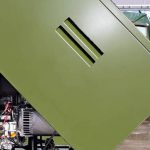Since it is an aluminum alloy die cast, it is not possible to cut the aluminum directly, but the aluminum must be melted into a fluid to facilitate subsequent molding on the die
Once these metals become fluids, they can be injected into die-casting machines and die-cast into prototype metal shells for mobile phones. It sounds relatively simple, but you need to prevent sand holes from appearing in the shell process even with such links. If there are holes in the sand, subsequent processing and cutting will create small holes, so the knot between the process and the die needs to be improved. This trial and error improvement process wastes a lot of raw materials.
Painting stage
After the end of the previous die-casting stage, these prototypes accept the following options: Are they anodized like the iPhone to enhance the texture of the metal, or are they direct? This looks like a difficult decision. For aesthetics: Die-cast housings do not help with anodic oxidation. There are considerations such as product differentiation.
After machining, you can see that the excess is washed away, the burrs are worn away, and the metal case of the mobile phone is basically formed. The above openings are reserved for injection molding. The small holes in the back cover are CNC machined for injection molding and reinforcement. This logic is the same as the white strip on the back of the iPhone 6. To smooth the antenna signal, the back cover cannot use the entire piece of metal. Therefore, traces of plastic are always visible on the antenna part. Currently, there is no way to overcome this, and this part of the plastic is not the spray point.
After injection molding is complete, after re-grinding, the next step is the painting process. Manufacturers never use the above plain shells directly. The process of spraying paint is also a technique. Mobile phones have a clear boundary between the plastic and metal parts on the back. If the painting process is inadequate, this dividing line will remain visible and will not show the visible boundaries of the Ministry of Metals and Plastics. It is an important indicator to judge whether the painting process is good.
When you finish painting, the paint will be burned. Generally speaking, painting and baking are not done at once, but in many cycles. And there is another polish between the paint and the spray paint. This group of cell phone metal shells finally goes through 5 sprays, 5 paints and 2 polishes. Usually the first is a primer and the last is pearl powder or aluminum powder added to the paint to ensure texture and appearance.
At this point, it’s the part most mobile phone makers like. Because this part has a very nice part called diamond cutting. But before cutting diamonds, manufacturers need to make holes in cameras, volume keys, speakers, and so on.
After each hole is opened, it is a very mysterious diamond cutting link. Cutting diamonds is not because the cutout frame is as transparent as a diamond, but it is said that the tool that completes the cutting is the diamond. The edges of the cut case have a very nice highlighting feel. It’s not exactly like the previous paint spray. Diamond cutting here cannot be completed at once. At least two or three times is the conscience of the industry. After all, one more step, the cost increases.
Note that it is necessary to use a kind of laser tool setting device to control the thickness of the knife edge and the width of the trimming edge to ensure that the width and angle of the cut are strictly consistent. is needed. Simply put, use a laser cutter to cut around the first place. The measurement data is fed back to the cnc machine according to the shape of the object to be measured, and cutting can be started.
Please keep the source and address of this article for reprinting:Precision machining of mobile phone shells by die-casting aluminum
Reprint Statement: If there are no special instructions, all articles on this site are original. Please indicate the source for reprinting.:Cnc Machine Wiki,Thanks!^^

